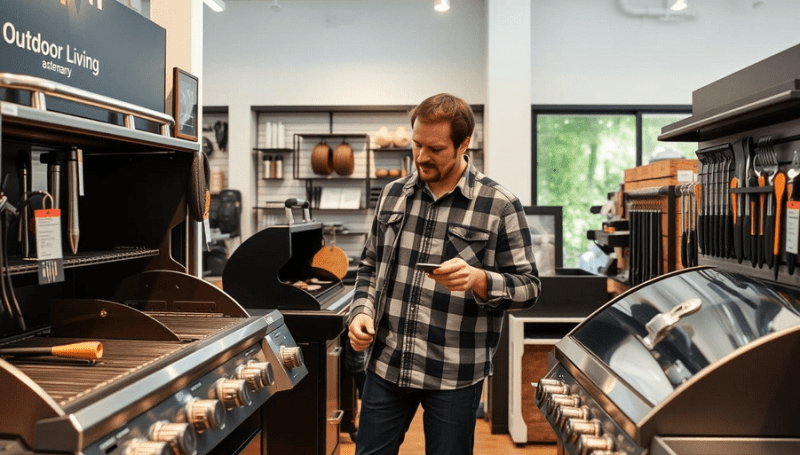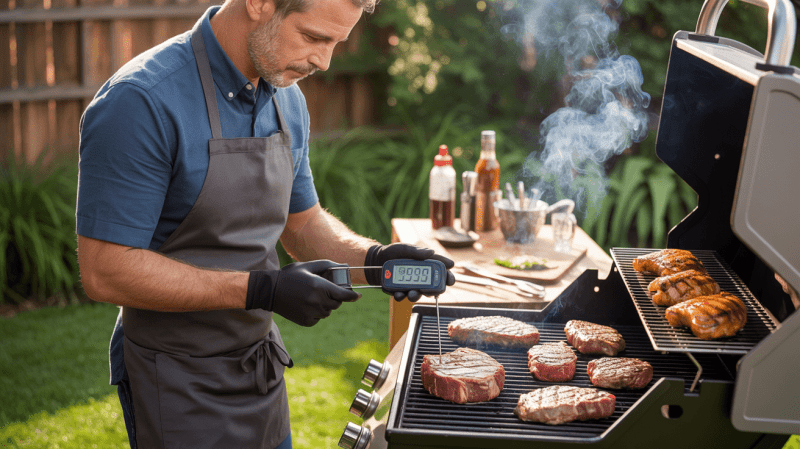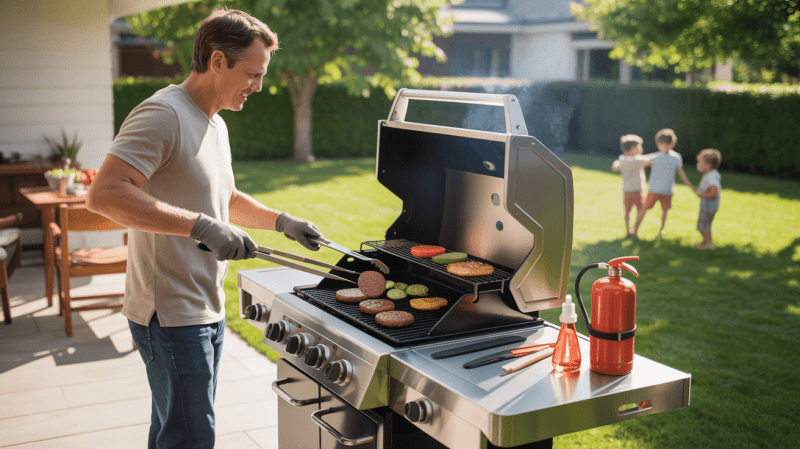Designing the perfect outdoor kitchen starts with carefully planning the space. We need to consider how much room we have and what elements are most important to us. Choosing the right appliances and layout is crucial for a functional and enjoyable outdoor kitchen. This means thinking about how we will cook, eat, and entertain in our outdoor living space.

Creating the right ambiance can make our outdoor kitchen a favorite spot for gatherings. Lighting, seating, and decor play a big role. We should think about how these elements can extend the functionality of our area beyond just cooking. This way, we can enjoy our outdoor kitchen at any time of the day or night.
Key Takeaways
- Start with planning the layout and essential features.
- Choose appliances for function and style.
- Enhance the space with seating and lighting.
Planning Your Outdoor Kitchen Design
Designing an outdoor kitchen involves careful consideration of the space, materials, and functionality. It's important to evaluate location, accessibility, and budget to create an efficient and aesthetically pleasing area.
Assessing Your Outdoor Space
First, we need to evaluate the available space. Measure the area to know how much room we have. It's key to consider the layout of our yard or patio. This helps us place our kitchen elements, such as grills and counters. Recognizing the sun’s path and wind direction helps in ensuring comfort when cooking and dining. We should also look for power and water access points nearby, as these are crucial for lighting and appliances.
Plants and trees provide natural shade and privacy. Designating zones for cooking, seating, and socializing helps create a pleasant flow. Lighting and landscaping can enhance the area’s mood and function. While analyzing the environment, let's remember potential expansion needs in the future.
Considering Functionality and Accessibility
Creating a functional layout makes our kitchen user-friendly. Think about work zones where grilling, prepping, and socializing are close yet distinct. Placing frequently used items within easy reach streamlines our outdoor cooking. Safety is a priority, so ensuring clear pathways is essential.
Accessibility for all age groups and mobility levels is important. Adding ramps or wide pathways makes a difference. Let's consider the location of doors and windows to ease traffic flow. Storing utensils and supplies nearby can reduce trips indoors. By thoughtfully organizing our space, we can focus more on enjoying meals with friends and family.
Choosing Durable and Weather-Resistant Materials
Selecting the right materials is crucial. Weather-resistant options such as stainless steel and stone endure outdoor conditions well. These materials resist rust, decay, and color fading. Concrete or tile countertops provide durability and ease of cleaning.
When picking furniture, we should look for items labeled as waterproof and UV-resistant. Investing in covers for appliances and surfaces extends their life span. We should also maintain wood surfaces regularly to prevent damage. Creating a list of preferred materials helps us stay within our style and resource needs.
Working With a Budget
Budgeting guides our choices without compromising quality. Listing priorities like appliances, seating, and lighting helps us allocate funds wisely. It’s good practice to research prices and compare brands. Monitoring ongoing sales offers opportunities to save.
Factoring in maintenance and utility costs avoids surprises. We might opt for fewer but more high-quality features if the budget is tight. Exploring DIY options can also reduce expenditures. Flexibility is key as we might need to adjust plans based on costs. Keeping track of every expense helps us manage funds effectively.
Selecting Appliances and Layouts

In an outdoor kitchen, the choice of appliances and layout shapes functionality and style. Our focus will be on selecting vital appliances, considering various layout options, and exploring custom features that might enhance the space.
Essential Outdoor Kitchen Appliances
Begin with the grill, the centerpiece of outdoor cooking. Gas grills offer convenience and control, while charcoal grills add rich flavor. Pizza ovens can make family pizza night memorable. For those who love smoked delicacies, smokers are an excellent addition.
Consider integrating refrigeration and storage to keep ingredients fresh and essentials at hand. A sink is crucial for washing produce and hands. These staples allow us to enjoy a seamless cooking experience under the sky.
Evaluating Layout Options
Choosing the right layout maximizes efficiency and aesthetics. An L-shaped layout offers plenty of counter space and accommodates multiple appliances. This design suits both large parties and small gatherings.
For a smaller space, a kitchen island can serve as both a prep area and dining spot. If space is limited, a straight-line layout might work best, keeping everything within easy reach to avoid clutter while maintaining functionality.
Custom Features and Add-Ons
Custom features help tailor an outdoor kitchen to our needs. Add-in LED lighting for nighttime cooking or entertaining. Consider installing a pergola or awning for protection from the elements, which extends usage time.
In colder climates, patio heaters can make the space usable year-round. For a touch of luxury, incorporate outdoor sound systems or flat-screen TVs. These extras make our kitchen not just a cooking area but a social hub.
Creating Ambiance and Dining Spaces

Designing the perfect outdoor kitchen involves creating inviting dining spaces and the right ambiance. Key elements include seating arrangements and thoughtful lighting choices that transform our outdoor kitchen into a functional and charming place for family meals or gatherings.
Incorporating a Dining Area and Seating
When planning for a dining area, choosing furniture that is both comfortable and durable is essential. Weather-resistant materials like teak or treated metal work well.
Tables come in various styles. A large table is ideal for group gatherings, while smaller bistro sets fit cozy spaces.
Seating choices influence comfort and space usage. Consider stackable or foldable chairs for versatility. Adding cushions can enhance comfort but ensure they are made from fabrics that withstand outdoor conditions.
Adding Lighting and Decorative Elements
Lighting plays a crucial role in setting the ambiance. Use string lights for a warm, enchanting glow above the dining area. Solar-powered or LED lanterns are energy-efficient and decorative. Consider path lights for safety and navigation around the space.
We can enhance our dining area with decorative items like potted plants or outdoor rugs to add charm. Choose decor that complements the environment and withstands weather changes. This helps create a cohesive look, ensuring our outdoor kitchen is both stylish and functional.
Extending Functionality Beyond Cooking

An outdoor kitchen can be more than just a place to cook. By adding elements for entertainment and creative landscaping, we can enhance the space's appeal and make it a focal point for gatherings.
Integrating Entertainment Elements
To transform our outdoor kitchen into a lively gathering spot, adding entertainment features is key. One popular option is an outdoor fire pit or fireplace. They provide warmth and create a cozy atmosphere for evening gatherings.
A poolside bar can make serving drinks easy and fun, especially for pool parties. Including a sound system for music will set the right mood. We might also consider a TV for watching games or movies. Including comfortable seating around these features will make the space inviting and enjoyable for guests.
Exploring Creative Landscaping
Landscaping around the outdoor kitchen enhances the look and feel of the space. We can add an herb garden, which is both practical and beautiful. Fresh herbs like basil and rosemary are just an arm’s length away, perfect for spicing up our grilled dishes.
Adding a pergola over the kitchen area provides shade and also allows us to install lighting for nighttime use. By incorporating natural elements like stones, plants, and water features, we can create a serene escape. Designing a path from the barbeque to the dining area can also help organize the space and improve flow.
Frequently Asked Questions

When designing an outdoor kitchen, the layout, budget, and material choices all play crucial roles. It’s essential to consider space, the relationship to the house, and choose durable materials. Efficient kitchen shapes help maximize functionality.
What considerations are important when planning the layout of an outdoor kitchen?
We need to look at the available space and how we use it. Think about cooking zones, prep areas, and seating arrangements. Ensuring enough space for movement and workflow is key to enjoying the outdoor kitchen experience.
How can one build an outdoor kitchen within a limited budget?
We can get creative to stay within budget. Consider simple designs that use fewer materials. Reuse items where possible and choose cost-effective materials that still offer durability. Prioritize essential features and add extras later as funds allow.
What are the recommended dimensions for an outdoor kitchen?
The size of the outdoor kitchen depends on space and need. A small setup could be around 10 feet by 10 feet, while a larger space might be 12 feet by 18 feet. It’s important to tailor dimensions to our specific cooking and entertaining needs.
What factors determine the ideal location of an outdoor kitchen in relation to the main house?
An outdoor kitchen should be close enough to the house for convenience but far enough to avoid smoke entering the home. We should consider wind direction, sun exposure, and easy access to utilities. Nearby shelter can also protect the kitchen from weather.
What shapes are most efficient for outdoor kitchens to maximize functionality?
U-shaped and L-shaped kitchens often work well outdoors, providing easy access to different cooking zones. These shapes help maximize space and allow for efficient movement while cooking, prepping, or socializing. It’s crucial to match the shape to our space and needs.
Which materials are best suited for constructing a durable and weather-resistant outdoor kitchen?
We recommend using materials like stainless steel, stone, and treated wood. Stainless steel is rust-resistant, while stone offers a natural look with toughness. Treated wood can be a warm touch, but it should be well-sealed to withstand the elements.
DISCLAIMER
This document is provided for general information purposes only and should not be relied upon as providing legal advice, technical, or specific operational guidance to the reader, whether as to the practices described in the document or the applicable legal requirements and regulations. backyardgrillingpros.com expressly disclaims any responsibility for liability arising from or related to the use or misuse of any information in this document.


